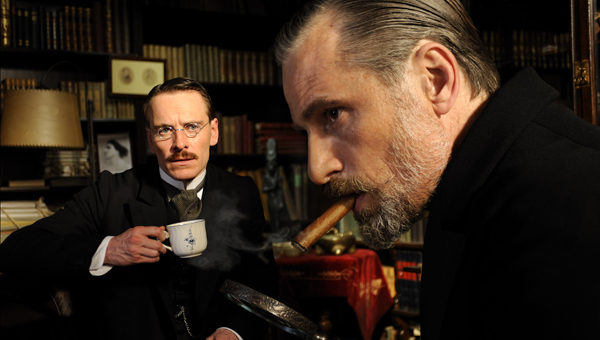A Dangerous Method Review

It’s good to talk.
You might expect a creed as such from the world’s first psychologists, but sometimes even the most eminent authorities struggle to say how they truly feel.
A troubled young soul who seems to be torn between hysterical laughter and tormented wailing is brought kicking and screaming to a medical facility by a bevy of burly men.
This is Sabina Spielrein and, if you believe in judging a book by its cover, a woman with a very deep rooted problem.
Having wanted to be taken to Vienna’s pre-eminent authority on matters of the mind, the paterfamilias of psychology Sigmund Freud, Spielrein instead finds herself brought to the medical attention of a young, well, Carl Jung.
At first, Miss Spielrein is resistant to both Jung’s radical new teaching methods of talking about her problems and the man himself.
But it doesn’t take long for the traditional transference of the dr / patient relationship to kick in as Spielrein’s attraction to Jung’s authority over her begins to surface.
Something that Jung openly reciprocates, as his own wife doesn’t challenge his mind nearly as much as Sabina does.
The only other intellectual equal in Jung’s life appears to be the patriarchal figure of Freud himself, who happily mentors this younger doctor at his family home so they can talk more about their similar yet divergent thoughts about psychoanalysis.
But as Jung and Spielrein evolve their beliefs independently of each other as well as father figure Freud, the destruction and subsequent creation this causes bears consequences for this talkative trio.
Based upon Christopher Hampton’s play A Talking Cure, which he also adapted for the big screen version, A Dangerous Method is in a lot of ways an unusual film.
David Cronenberg, famous for his visually pioneering movies such as Scanners and Videodrome, directs a stellar ensemble cast in a dialogue heavy, action light major production.
Michael Fassbender trades in his shame persona to portray Dr Carl Jung; curing patients of their sexual peccadilloes instead of acting out his own fantasies.
Actually, that’s not entirely true.
His explicit scenes with gorgeous boy Keira Knightley as Jung’s patient, mistress and muse Sabina Spielrein are most definitely in keeping with his recent Steve McQueen collaboration.
As is Fassbender’s pitch perfect performance as the pivot through whom all the other characters are connected by.
Viggo Mortenson is equal parts commanding and funny as Sigmund Freud, which won’t come as a surprise to anyone familiar with his immersive acting style.
And Vincent Cassel is fun in his cameo role as Otto Gross, a man who’d probably make a hedonist blush with his animalistic acts of indulgence.
Yet it’s Knightley who will be on the tip of your tongue after you’ve seen A Dangerous Method.
With Spielrein starting out on the brink of a nervous breakdown, Knightley decides acting big is the best way to communicate her madness.
Jutting out her already emphasised lower jaw and adopting a rough eastern European accent that could be either German or Russian, the actress best known for her restrained period characters thrashes and wails about whilst stuttering and stammering over her words as she confronts the demons of her own mind.
Even now, I’m still undecided as to whether Knightley’s performance is laughable or worthy of an Oscar.
Regardless, her emotional and physical portrayal of Spielrein offers a necessary counterpoint to all the studied words and theory on offer from the two doctors in her life.
Displaying raucous wit and sexually adventurous material, A Dangerous Method is even easy enough to grasp for psychological philistines such as myself; offering up a light and accessible path into the scholarly world of psychology’s origins.
If that’s not worth talking about, than consider me a lost cause.
Jonathan Campbell